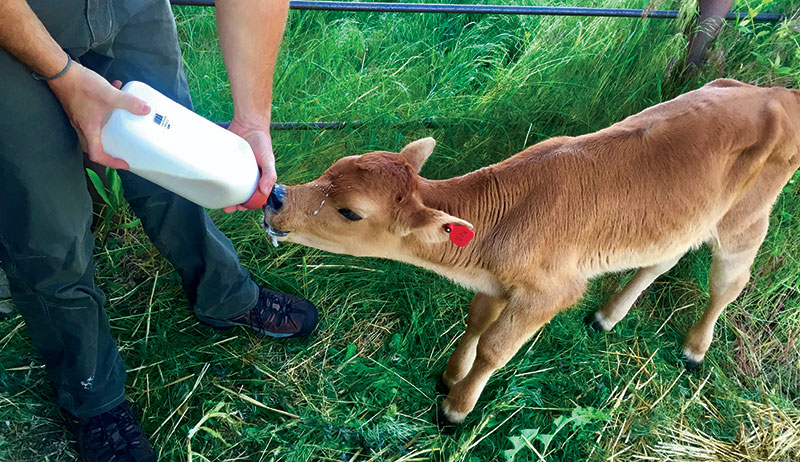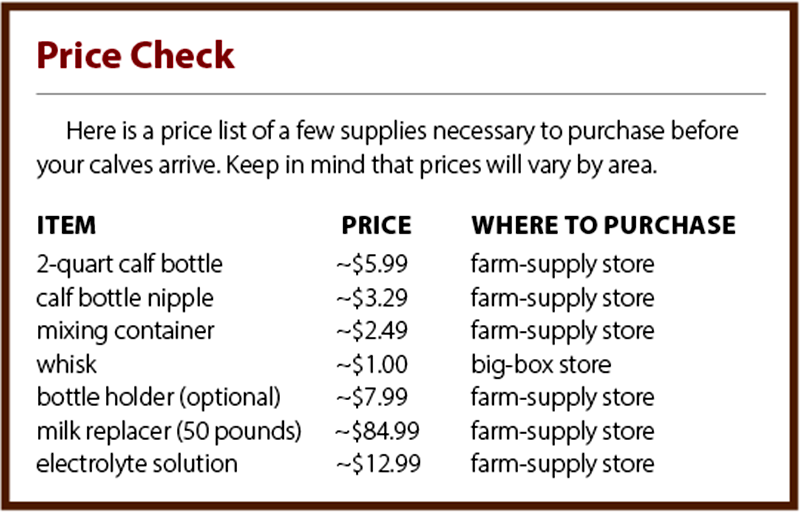
Feeding bottle calves can be a great alternative to purchasing older cattle if you are willing to put in the work and pay attention to the details. Feeding bottle calves can be a rewarding experience, but there are some important things to know about keeping them healthy, how and when to introduce dry feeds, and what to do if they do get sick.
Purchasing Plans
Bottle calves can be purchased at any time after birth, but I recommend purchasing an older bottle calf, between 6 and 8 weeks old. Slightly older calves travel and adjust to environmental changes more easily than very young calves.
When purchasing a calf, here are some important questions to ask:
- Has the calf been vaccinated? Vaccinations shortly after birth are vital to a healthy calf.
- Was the mother cow on a proper vaccine schedule prior to calving? Immunity to some diseases is gained via passive transfer from the mother to the calf, and this is also vital for calf health and vitality.
- Is the bottle calf currently being fed fresh milk? Or milk replacer? If it is being fed milk replacer, what is the brand and feeding schedule?
- If the calf is a male, has it been castrated or banded yet? Try and purchase intact bull calves; banding or castrating early can invite infection, and leaving your calf intact for a few months will not cause them to develop bull-like characteristics or behavior.
- Healthy calves will be active, have bright eyes, be eager to eat, head-butt the bottle and wag their tails while they eat. Sick calves will not want to get up; they will be uninterested in the bottle, be lethargic, and have droopy ears and dull eyes.

It’s best to purchase more than one calf; having a group of two or more minimizes stress. They grow much better if they have a companion to compete with. Keeping your calves on the same milk replacer and feeding schedule right when you purchase them will also minimize stress and the possibility of illness. You can make changes, but make them gradually, over the course of a week.
Beyond the Bottle
In addition to bottle-feeding a calf, be sure to provide free-choice water, calf starter and grass hay. Calf starter is a specifically formulated grain mix balanced for calves. Feeding calf starter right away helps the rumen develop correctly. Hay also helps rumen development, specifically rumen size. Both of these are important for the future feed efficiency of the animal, which matters a great deal for producing meat or milk.
On-Hand Supplies
You need to purchase a few supplies before your calves arrive, such as bottles, a mixing container, milk replacer and more.
Calf Bottles are usually of a common size; providing 2 quarts per feeding is typical on a twice-a-day schedule, which is the most common. Calves can also be fed three times a day; your schedule might vary. Just keep the feeding times and amounts consistent.
A Graduated Mixing Container with a spout can make measuring water accurate and pouring the mixed milk into the bottle easy. It’s worth the investment. Accuracy when mixing milk replacer is important, and because you will do it often, making it convenient is a good idea. Measurements listed on the bottle, mixing vessel and replacer bag will probably all be different. To simplify, use these conversions: 2 quarts equals one-half gallon equals 64 ounces.
The Milk Replacer contains instructions for how to make the correct mix based on the nutrients. Make sure you mix it correctly. Making a mistake on the math when mixing milk replacer could make your calves sick.
Feed-supply stores often have several options for milk replacer. None is cheap. Purchase a 50-pound bag for the better value. Some milk replacers are for calves from 2 to 60 days old, while some are for older calves, about 21 days. Pay attention to the label; the nutrition varies depending on the age of the calf due to stomach development.
Medicated Milk Replacer is also available. Medicated milk replacer helps prevent scours (diarrhea in calves). Keep some on hand, especially if your calves are under stress or already have loose stool when they arrive, or if you just want to take an extra precaution.
I keep a 25-pound bag so I can feed it right away, if necessary.
Electrolyte Solution is another thing I keep stocked when feeding bottle calves. This is available in bulk and is very affordable. Calves get dehydrated very easily, especially when they have even a mild case of scours. Having electrolyte is especially important if you are bottle-feeding calves during hot months.

Bottle-Feeding Steps
- Begin with clean hands, clean bottles and clean mixing vessels.
- Mix the milk replacer with warm water according to the brand instructions. Warm water is important in dissolving the fats in the milk replacer.
- Pour the milk replacer into the bottle, and snap on the nipple.
- Teach the calf to take the bottle by dripping some milk on your fingers and then letting the calf suck on your fingers. Gradually transition to the bottle.
- Hold the bottle steady; the calf will move around but will come back to the bottle. It might need a little guidance to re-latch at first.
- If you don’t want to hold the bottles while you feed the calves, purchase bottle holders. This isn’t necessary but can be easier for children because calves instinctually head-butt while they drink. (When a calf nurses on its mother, it head-butts the udder to stimulate milk let down.)
- Thoroughly clean everything used to bottle feed your calf after it’s finished eating, and let it dry completely. Store it somewhere clean and dry. I use plastic totes kept in my tack room.
It’s important that you do not overfeed your bottle calves. Calves will eat until they are sick. The calf will look skinny and seem hungry every time it sees you. But feed only the recommended amount; overfeeding can cause overeating disease, a bacterial disorder that will quickly kill calves.
The bacteria that cause overeating disease, Clostridium perfringens (types C and D), occur naturally in the environment and also in the calves’ intestinal tracts. Problems with the bacteria occur when excess nutrients are available, which allows them to proliferate and cause disease. Vaccinations are available to prevent this, which is why knowing whether your calf and the cow that carried it were vaccinated properly is very important. The C and D vaccine can be effective until the calf is 6 weeks old, so getting this vaccination done quickly, if it’s necessary, is important.
Diarrhea Dilemma
Other common diseases in calves are scours and pneumonia. Scours is caused by stress, usually related to nutrition. Prevention is best, but even if you do everything right, calves will sometimes still get scours.
If any of your calves get scours, treating them as quickly as possible is the key to success. While there is obviously danger from the calf being sick, the other danger comes from dehydration.
Here is an outline of how to discover and treat scours:
- Observe calves regularly, especially after traveling or major weather changes. Scours and pneumonia are big risks.
- Scours is essentially diarrhea, and there will be no question when they have it. If you don’t observe them having a bowel movement, you will smell it. You can also see it on the fur around their hind ends.
- Call a veterinarian, and get the correct antibiotics right away. If you’re not comfortable giving shots and don’t have someone to walk you through it, you can also give pills. (To do this, you will need a pill gun, which can be easily purchased at a farm-supply store.) Administering treatment as soon as you suspect scours is best.
- Supplement or replace nonmedicated milk replacer with a medicated version.
- Feed an electrolyte mix as often as the label directs for as long as the illness lasts. Even after calves recover, continue to feed electrolyte solution at least once a day, every other day for a few days. This is like a sports drink for calves and prevents dehydration.
- If your calf is really struggling, you
might need to tube feed. (See “Tube-Feeding Basics” below for more info.) You can find a tube-feeder at a local farm-supply store. If you’ve never done this, be sure to have someone with experience show you how. If done incorrectly, you can accidentally place the tube in the lungs and drown the calf. - The most important thing to remember when treating sick calves—or doing anything like this with any animal—is to remain calm and take your time. These situations can be stressful, but being calm and collected will help you get things done more quickly, make better decisions for your calves and help the calves trust you.
With the proper antibiotics and an extra boost from electrolytes, you should be able to help your calf recover within a few days. Never try to determine treatment on your own, always consult a veterinarian for help or recommendations and call a more experienced friend to assist you if you need further assistance.
Raising bottle calves is one of the most rewarding experiences on the farm. If you have all the information you need before you get started, you will be set up for success. Preventing illness is key, but if you are watchful, you can catch any issues right away. Consulting with a veterinarian as you raise your calves will help you keep them healthy and happy.
This story originally appeared in the March/April 2018 issue of Hobby Farms.




